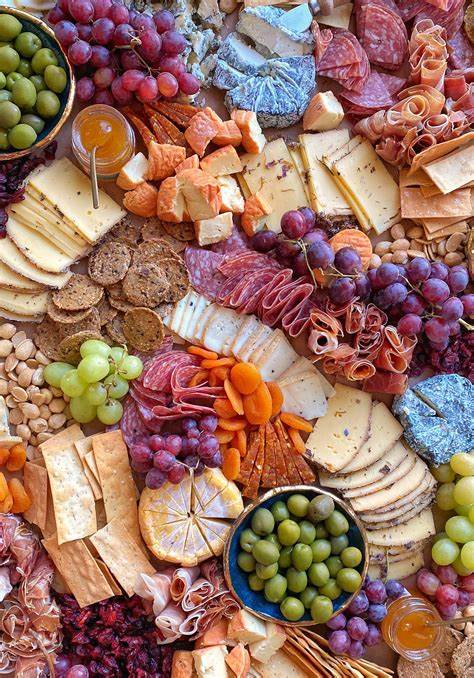To me, this is overdone, too crowded.
Six
years ago, when I first moved into the cottage, everybody wanted to come for
happy hour so they could see my new digs. We had guests every night, and it was
fun and, indeed, happy. Jordan and I put out a cutting board with a couple of
meat or salami choices and two or three cheeses—a wonderful cheddar with blue
cheese layered in or sometimes cheddar from the Cotswolds. We didn’t call it
chaucuterie because, if my memory is correct, that term has only become popular
since then.
Today,
charcuterie boards are all the fashion. There are books about how to do them,
and you can take classes in constructing them. Hostesses seem to be in fierce
competition to see who can have the most elaborate, the most innovative board.
Frankly, I think it’s gotten out of hand. For one thing, those elaborate,
overflowing board may be beautiful, but they’re not practical. How do you pull
out a piece of cheese or a pickle spear or whatever without touching all the
food on the platter? I was raised to believe if you touched it, you ate it. I
want a little space between items—and a pickle fork.
If you
can shop at a store with a good deli counter, you’ll have a much wider range of
choices. You really need three things on your board:
Meat –
figure 2 to 3 ounces per person and try for variety of taste and texture. Cured
meats are usually used, and pork is traditional, but you can include other
meats. Salami is always a good choice—either soft or hard; I like mortadella—a fine,
soft Italian meat (think bologna) with little pockets of pork fat; you can use
prosciutto, bresaola, chorizo, ham, pepperoni. I love a good pate. Most people
think pate is duck or chicken liver and those are most common, but pâté can be
made of beef, game, fish, even vegetables. It is usually richly seasoned with
herbs, spices, and either wine or brandy. Often, they are made in a loaf or
terrine pan, chilled, and sliced. A pate is smooth enough to spread.
Ingredients in a terrine are coarsely chopped.
Cheese
– again, 2 to 3 ounces per person. Use a soft cheese, like brie, goat cheese
(chevre) or camembert – if the cheese will be messy on the board, place it on a
small plate or coaster or piece of parchment; add a semi-soft or hard cheese – cheddar,
gouda, manchego; to add interest to your board, choose an unusual cheese—like blue
or gorgonzola. Slice the cheese before arranging the board—if people have to
slice their own pieces, your board will soon be a mess.
Bread –
you can hardly go wrong here with anything from lavash to Ritz crackers. Try
cocktail rye or baguette slices. Sometimes we use sesame rice crackers but be aware
they break easily. Try Melba toast or water wafers. Most groceries have a wide
selection of crackers.
Some
hosts consider a meat and cheese board ample enough; others like to add fruit
and what I call garnishes:
Fruit –
grapes are the standby and easiest, but you can do chunks of melon in season,
strawberries (halve them if large), figs. Avoid soft fruits, like bananas and
raspberries, and blueberries which roll around. You can also offer a tiny pot
of jam or chutney. In winter, dried fruits may be your best choice.
Garnishes
– again, let your imagination rule. Add anything from cornichons and olives or
tapenade to nuts or dips; smoked shellfish or mild white anchovies are nice but
put them in a small dish so they don’t touch the non-fishy items. How about
tiny cherry tomatoes or pickled onions. Bits of fresh herbs tucked here and
there add great eye appeal.
Note:
you can do vegan and gluten-free boards if you or a guest have special needs.
Covid
really changed our attitude toward charcuterie because we were all so conscious
of sanitation. Boards faded from our happy hour about that time, at least in my
cottage. You may still be leery of the communal aspect of charcuterie, but
there are options: Cone charcuterie is layered in pre-made cones (no, I don’t
know where to get them). Some hostesses layer ingredients in small Mason jars, preferably
wide-mouth, and call it jarcuterie. Or you can do charcuterie kebabs. With
these alternative forms, it might be good to provide small plates and a fork to
each guest—or a lot of toothpicks.
The good
thing about these boards is that you can tailor them to your taste and the
specific situation. Let your imagination run and have fun with it. And take
pictures.


No comments:
Post a Comment